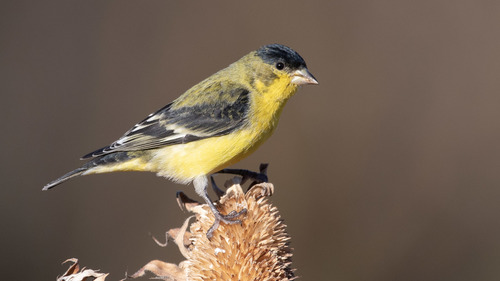
Lesser Goldfinch
The Lesser Goldfinch (Spinus psaltria) is a small, vibrant songbird native to the Americas. Known for its bright yellow plumage and melodious song, it plays a crucial role in seed dispersal across its range. It's a common sight in gardens and open woodlands, adding a splash of color and cheerful sound. While not as widely recognized as some other finches, the Lesser Goldfinch holds a special place in the hearts of birdwatchers and contributes significantly to the ecological health of its environment. It has no specific major cultural significance, but its lively presence is appreciated by many.
9-12 cm
Length
15-20 cm
Wingspan
Least Concern
Conservation Status
Distribution
The Lesser Goldfinch is found from the southwestern United States through Mexico and Central America, extending into parts of South America, including Colombia, Venezuela, Ecuador and Peru. Some populations are resident, while others, particularly in the northern part of their range, are migratory, moving south for the winter. Altitudinal range varies from sea level to over 2,500 meters.
Lifespan
Typically 3-4 years in the wild, although some individuals may live longer. Captive birds can live up to 7 years.
Lesser Goldfinch's Habitat
Habitat Types
Open woodlands, Scrublands, Gardens, Parks, Riparian areas
Climate Zones
Temperate, Subtropical, Tropical
Adaptations
Their small size and agility allow them to exploit a variety of seed sources, including those on thin, swaying stems. Their beaks are adapted for efficiently extracting seeds from thistles and other composite flowers.
Variations
Several subspecies are recognized, differing slightly in plumage and size. For example, *Spinus psaltria hesperophilus* is found along the Pacific coast and is known for its darker back in males, while *Spinus psaltria psaltria* is found in the interior southwestern US and Mexico.
Appearance
Breeding Plumage
Males in breeding plumage are bright yellow below and greenish to black above, with white wing patches. Non-breeding males are duller, with more olive coloration. Females are generally duller than males, lacking the strong black or green back.
Seasonal Feather Changes
Plumage is brightest during the breeding season (spring and summer). After breeding, birds molt into a duller, less conspicuous plumage.
Sex Based Plumage Differences
Males are typically brighter and more distinctly patterned than females, especially during the breeding season.
Notable Features
Small, conical bill, White wing patches, Black cap (in some subspecies), Forked tail
Diet and Feeding
Primary Foods
Seeds, Insects (especially during breeding season), Small fruits
Foraging Behavior
Lesser Goldfinches are primarily seed-eaters, foraging in small flocks, often clinging to seed heads of plants like thistles and sunflowers. They are acrobatic feeders, able to hang upside down to reach seeds.
Specializations
Their conical bill is well-suited for cracking small seeds. They have a particular fondness for seeds of the Asteraceae family (e.g., thistles, sunflowers).
Seasonal Diet Variations
During the breeding season, they consume more insects to provide protein for their growing young. In winter, they rely almost entirely on seeds.
Behavior
Social Structure
Lesser Goldfinches are generally social birds, forming small flocks outside of the breeding season. During breeding, they may be territorial, defending the area around their nest.
Communication
Melodious songs, often described as a 'twittering' or 'warbling', Short call notes, including a distinctive 'po-ta-to-chip' call, Visual displays, such as wing fluttering during courtship
Migration
Some populations are migratory, moving south for the winter. The extent of migration varies depending on the region and food availability.
Territorial or Group Behaviors
During the breeding season, males defend small territories around the nest. Outside of breeding, they are often found in mixed-species flocks with other finches and small birds.
Conservation
Threats
Habitat loss (due to agriculture and urbanization), Pesticide use (affecting insect prey), Collisions with windows
Protection Programs
General habitat conservation efforts, Promotion of bird-friendly gardening practices
Local National Laws
Protected under the Migratory Bird Treaty Act in the United States.
Population Trend
Stable
Population Estimates
The global population is estimated to be around 9.8 million individuals.
Interesting Facts
Lesser Goldfinches are highly adaptable to human-altered landscapes.
They are frequent visitors to backyard bird feeders, especially those offering thistle (nyjer) seed.
They often line their nests with plant down.
This provides insulation and helps keep the eggs and chicks warm.
Their song is complex and variable.
Males can learn new song elements throughout their lives.
Faqs about Lesser Goldfinch
What do I feed Lesser Goldfinches?
They are particularly fond of thistle (nyjer) seed, but will also eat sunflower seeds and other small seeds. Providing a variety of seeds is best.
How can I attract Lesser Goldfinches to my yard?
Provide a source of fresh water, plant native seed-bearing plants, and offer thistle seed in a feeder. Avoid using pesticides.
Are Lesser Goldfinches aggressive?
They are generally not aggressive towards other bird species, although males may defend their nesting territory during the breeding season.
Do Lesser Goldfinches mate for life?
Lesser Goldfinches are not known to mate for life. They typically form new pair bonds each breeding season.
Copyright @ Nature Style Limited. All Rights Reserved.
 English
English